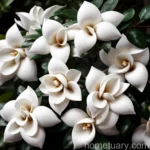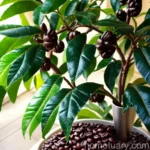Gardenia (Gardenia jasminoides ‘Crown Jewel’): The Ultimate Guide
Gardenia (Gardenia jasminoides ‘Crown Jewel’) is a stunning flowering plant known for its aromatic blossoms and glossy green leaves. With proper care, it can enhance the beauty and fragrance of any garden or indoor space. In this comprehensive guide, we will explore all aspects of gardenia care, from cultivation and maintenance to addressing common issues that may arise. Whether you are a seasoned gardener or a beginner looking to cultivate gardenias, this guide will provide you with valuable insights and tips for nurturing these exquisite plants.
What is Gardenia (Gardenia jasminoides ‘Crown Jewel’)?
Gardenia jasminoides ‘Crown Jewel’ is a cultivar of Gardenia jasminoides, commonly known as the gardenia or cape jasmine. It belongs to the family Rubiaceae and is native to areas of Asia, including China, Taiwan, Japan, and India. This evergreen shrub is prized for its luxurious, sweet-smelling, white flowers and dark green, glossy foliage, making it a popular choice for gardens, landscapes, and indoor spaces.
Key Takeaways – Gardenia (Gardenia jasminoides ‘Crown Jewel’)
Before delving into the specific aspects of gardenia care, let’s highlight some key takeaways about the Gardenia jasminoides ‘Crown Jewel’:
- Scientific Name: Gardenia jasminoides ‘Crown Jewel’
- Family: Rubiaceae
- Common Name: Gardenia, Cape Jasmine
- Growth Habit: Evergreen shrub
- Flower Color: White
- Foliage: Dark green, glossy leaves
- Fragrance: Sweet and aromatic
Culture: Understanding the Growth Requirements of Gardenia
Cultivating gardenias successfully hinges on understanding their specific cultural requirements. From sunlight and water to soil and fertilization, providing the right growing conditions is essential for the plant’s overall health and vigor.
Uses of Gardenias
Gardenias are prized for various uses, including:
- Garden Ornament: Their beautiful flowers and glossy foliage make gardenias a popular choice for ornamental purposes.
- Fragrance: The sweet and alluring fragrance of gardenia flowers is often used in perfumery and aromatherapy.
- Decorative Purposes: Gardenia blooms are commonly used in floral arrangements and decorative displays.
Watering Gardenias
Proper watering is crucial for the health of gardenias. Here are some key considerations for watering these plants:
- Consistent Moisture: Gardenias prefer consistently moist, well-drained soil. Avoid letting the soil dry out completely between waterings.
- Avoid Overwatering: While gardenias require adequate moisture, overwatering can lead to root rot and other issues. It’s important to strike a balance and avoid waterlogging the soil.
Sunlight Requirements for Gardenias
Sufficient sunlight is essential for the growth and blooming of gardenias. Here’s what you need to know about their sunlight requirements:
- Partial Shade: Gardenias thrive in partially shaded areas with filtered sunlight. They typically benefit from morning sun and partial afternoon shade, especially in warmer climates.
- Protection from Harsh Sun: While gardenias require sunlight, they are sensitive to intense, direct sunlight, particularly during the hottest parts of the day.
Fertilizing Gardenias
Fertilization plays a crucial role in promoting healthy growth and flowering in gardenias. Consider the following tips when fertilizing these plants:
- Acidic Fertilizer: Gardenias prefer acidic soil conditions. Using a specialized fertilizer formulated for acid-loving plants can help maintain the ideal pH for these shrubs.
- Regular Feeding: During the growing season, gardenias can benefit from regular feeding with a balanced fertilizer designed for acid-loving plants. Follow the product instructions for application rates and frequency.
Soil Requirements for Gardenias
The right soil composition is essential for supporting the growth and vitality of gardenias. Here’s what to consider when it comes to soil:
- Acidic Soil: Gardenias thrive in acidic soil with a pH range between 5.0 and 6.0. Acidic soil promotes healthy root development and supports nutrient uptake.
- Organic Matter: Incorporating organic matter such as compost or peat moss can improve soil texture and fertility for gardenias.
Pruning Gardenias
Pruning is an important aspect of gardenia maintenance, helping to shape the plant, promote airflow, and remove dead or overgrown branches. Consider the following guidelines for pruning gardenias:
- Post-Flowering Pruning: Prune gardenias after the blooming period to remove spent flowers and shape the plant as needed.
- Sanitization: Use clean, sharp pruning tools to make precise cuts and minimize the risk of disease transmission.
Propagation of Gardenias
Propagating gardenias allows for the expansion of your plant collection or the sharing of gardenias with others. Here are some common methods for propagating gardenias:
- Stem Cuttings: Propagate gardenias from semi-hardwood stem cuttings, taken during the active growing season.
- Rooting Hormone: Using a rooting hormone can increase the success rate of stem cuttings when propagating gardenias.
Container Gardening with Gardenias
Grown in containers, gardenias can bring their beauty and fragrance to patios, balconies, and indoor spaces. Consider these tips for container gardening with gardenias:
- Well-Draining Soil: Use a well-draining, acidic potting mix designed for acid-loving plants when growing gardenias in containers.
- Appropriate Container Size: Select a container that provides ample room for root development while also allowing for sufficient drainage.
Popularity of Gardenia (Gardenia jasminoides ‘Crown Jewel’)
Gardenia jasminoides ‘Crown Jewel’ is a popular gardenia cultivar prized for its exquisite beauty and aromatic blossoms. This plant enjoys widespread popularity among gardeners and landscaping enthusiasts due to its captivating attributes, including:
- Luxurious, sweet-smelling white flowers
- Glossy, dark green foliage
- Versatility for both indoor and outdoor cultivation
- Contribution to ornamental and aromatic displays
Common Diseases of Gardenias
While gardenias are relatively low-maintenance plants, they can be susceptible to certain diseases. Recognizing and addressing these diseases promptly is essential for safeguarding the health of gardenias. Here are some common diseases and their potential treatments:
Disease Diagnosis and Treatment
- Leaf Spot: Leaf spot diseases can manifest as dark spots or lesions on the foliage. To address leaf spot, practice good sanitation and consider using fungicidal treatments if necessary.
- Root Rot: Overly wet conditions can lead to root rot in gardenias. Improving soil drainage and avoiding overwatering are essential for preventing and addressing this issue.
- Powdery Mildew: Powdery mildew can affect gardenias, leading to a powdery white coating on the leaves. Neem oil or sulfur-based fungicides can help manage powdery mildew.
Common Pests Affecting Gardenias
In addition to diseases, gardenias can also be vulnerable to various pests that can compromise their health and appearance. Here are some common gardenia pests and control measures:
Common Pests and Control Measures
- Aphids: These small, sap-sucking insects can cluster on new growth. Use insecticidal soap or neem oil to control aphid infestations.
- Whiteflies: Whiteflies can be problematic for gardenias, especially in greenhouse or indoor settings. Utilize yellow sticky traps and targeted sprays to manage whitefly populations.
Fun Facts About Gardenias
Gardenias are fascinating plants with a rich history and cultural significance. Delight in these fun facts about gardenias:
- Symbolism: In many cultures, gardenias symbolize love, purity, and refinement, making them popular choices for weddings and special occasions.
- Cultural Significance: In traditional Chinese medicine, gardenia extracts have been used for their potential healing properties and their ability to promote relaxation.
Botanist’s Tips for Growing Gardenia (Gardenia jasminoides ‘Crown Jewel’)
As a plant scientist and botanist, I recommend the following tips for growing and caring for Gardenia jasminoides ‘Crown Jewel’:
- Soil Testing: Regularly monitor the pH of the soil to ensure it remains within the preferred acidic range for gardenias.
- Mulching: Apply a layer of organic mulch around gardenias to help retain moisture, regulate soil temperature, and suppress weed growth.
- Air Circulation: Promote good air circulation around gardenias to minimize the risk of foliar diseases and fungal issues.
- Regular Monitoring: Keep an eye on the plant for any signs of stress, including wilting, yellowing leaves, or abnormal growth, and take appropriate measures to address any issues promptly.
Links to External Resources
For further information on gardenia care, cultivation, and maintenance, consider exploring the following external resources:
- The American Horticultural Society: Gardening with Gardenias
- University of Florida IFAS Extension: Gardenias at a Glance
- RHS Gardening: Growing Gardenias
- Plant Care Today: Gardenia Plant Care
- The Spruce: How to Grow and Care for Gardenia Plants
In conclusion, Gardenia jasminoides ‘Crown Jewel’ is a captivating plant with its lush, fragrant blooms and glossy foliage. By meeting its specific cultural requirements and promptly addressing any issues that may arise, you can cultivate and enjoy the beauty of this exquisite shrub in your garden, landscape, or indoor spaces.
Remember that successful gardenia care involves providing the ideal conditions for growth, monitoring for diseases and pests, and embracing the charm and fragrance that these plants bring to your surroundings. With the insights and tips provided in this guide, you can embark on a rewarding journey of nurturing and admiring the timeless allure of Gardenia jasminoides ‘Crown Jewel’.















